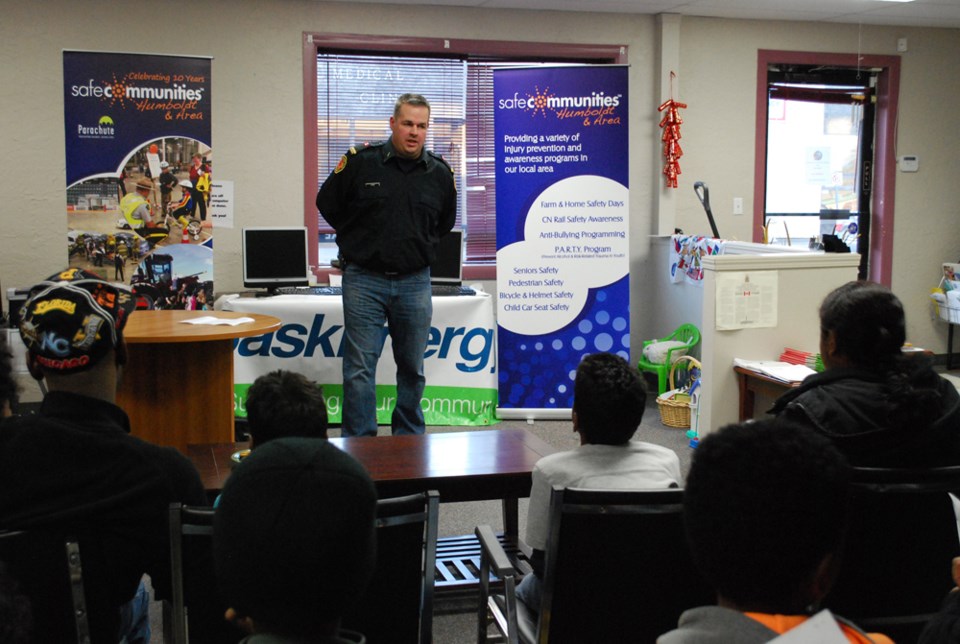Preparing Canadian newcomers can be very important, especially for those who have not seen snow yet.
“It can be a trying time,” says David Mortenson with Humboldt EMS, “between driving, cold weather and trying to stay warm.”
Through Safe Communities, newcomers were able to come to the winter preparedness workshops on Oct. 16 and Oct. 23 at the Newcomer Centre and learned all they need to know about winter.
Safe Communities coordinator Sheri Hinz says the information provided in the workshop can definitely save a life.
“Being that these individuals are new to Canada and experiencing their first winter for the most part, for all of those here today, any of that information that makes them thing twice about the choices they’re making when they’re deciding to travel or dressing for outdoor conditions are pretty important.”
Designing the workshop was a matter of deciding what we as Canadians face during the winter months; cold weather, travel, and heating your home are three of the basic issues.
A lot of things can surprise a Canadian newcomer but Hinz says temperature changes, how cold it gets and changing travel situations can come as a surprise to newcomers.
“When it seems like the conditions aren’t too bad within the city of Humboldt and then if you decide to venture out into the highway and open areas, those kinds of things can change and change very quickly.”
Mortenson, along with Brenda Shrader with SGI and Craig Stomp with Humboldt Fire Department, gave newcomers a variety of tips to stay safe during the winter months.
Mortenson gave first aid tips on knowing when to come in from the cold and what to do for hypothermia and frostbite.
“We want to make sure they are prepared for winter but we don’t want to scare them about winter. We want to make sure they enjoy winter.”
Being prepared is an on going thing, says Mortenson, but it can also be a great time. One of the tips that Mortenson was sure to bring up was for the kids in the audience.
“I talk all the time when there are kids in there that they don’t go and stick their tongue on a metal pole.”
Every year, Mortenson sees kids stuck to the poles and it’s no big deal, he says, but every Canadian knows how much that hurts.
“I’ve explained it to the kids because they’ve never experienced that before.”
Saskatchewan driving changes in winter and can turn dangerous really quickly.
Shrader wants everyone to have their cars prepared for winter driving conditions, including an emergency kit with food, water, candles, flashlights and shovels.
“If they have their car ready and what they need in their car, they’ll get through it fine.”
Shrader says she does not think newcomers know what to expect when they come but this is a way of preparing them. Again, they do not want to scare them but prepare them.
“It happens to all of us, we tell them car crashes happen and we hit the ditch and we get stuck. I’ve done it lots, that’s why I have my emergency kit.”
Stephen Juliette was there with his wife and three childrens. This wasn’t his first winter preparedness workshop but being from Mauritius, Juliette remembers how important the first workshop was.
“It was new because where I come from we don’t have snow, it’s a tropical island. Now we have to learn how to drive in Saskatchewan roads and clothing stuff.”
Making sure the kids are safe, learning how to dress them for the cold especially was a learning process for them.
“For the first it was really like a program for them, because they don’t know how the snow is, how cool it is. They learn by friends and at school how to live and how to stay warm during winter.”
Tips from SGI (http://www.sgi.sk.ca/individuals/safety/training/driveright/winterprep.html)
Winter driving guidelines
- When you’re on the road, remember to give yourself more time to reach your destination. Start your trip slowly, testing your braking and steering to ‘get a feel’ for the road.
- Once you’ve reached a level of comfort, you can gradually increase your speed. The key is to maintain control of your vehicle at all times, even if that means driving under the posted speed limit.
- Stay alert as you approach intersections. Scan the road for traction, such as sand or bare pavement, and always accelerate and decelerate gradually.
- If you do find your vehicle skidding, remain calm and take your foot off the accelerator. Don’t lock the brakes. Instead, brake steadily, look where you want to go and steer in that direction.
- Try to avoid using cruise control on the highway during the winter. Icy sections on otherwise dry surfaces can cause your wheels to spin, compromising your control of the vehicle and putting you at risk of a collision.
- Leave at least a 3-second following distance between your vehicle and the 1 in front of you. If the driver ahead of you suddenly brakes, you’ll have the time and space needed to stop safely, ensuring that you and everyone on the road arrives at their destination safely.




